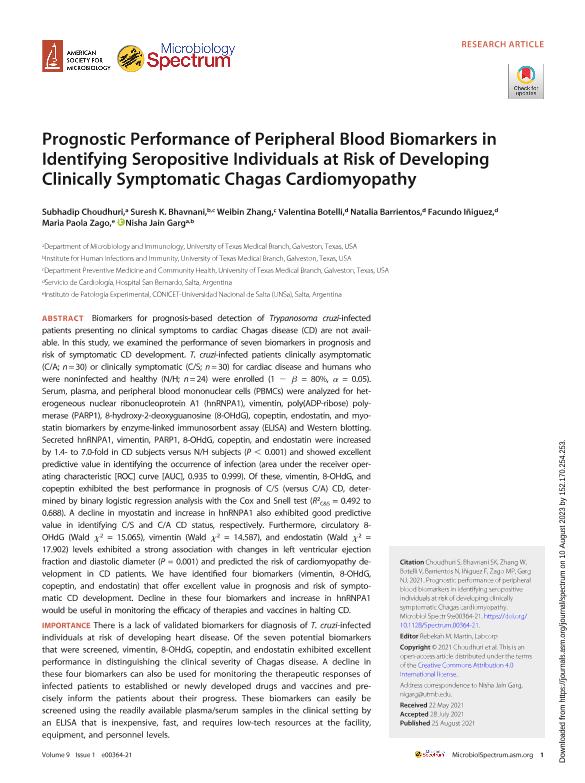Artículo
Prognostic Performance of Peripheral Blood Biomarkers in Identifying Seropositive Individuals at Risk of Developing Clinically Symptomatic Chagas Cardiomyopathy
Choudhuri, Subhadip; Bhavnani, Suresh K.; Zhang, Weibin; Botelli, Valentina; Barrientos, Natalia Mariel; lñiguez, Facundo; Zago, María Paola ; Garg, Nisha Jain
; Garg, Nisha Jain
 ; Garg, Nisha Jain
; Garg, Nisha Jain
Fecha de publicación:
09/2021
Editorial:
American Society for Microbiology
Revista:
Microbiology Spectrum
ISSN:
2165-0497
Idioma:
Inglés
Tipo de recurso:
Artículo publicado
Clasificación temática:
Resumen
Biomarkers for prognosis-based detection of Trypanosoma cruzi-infected patients presenting no clinical symptoms to cardiac Chagas disease (CD) are not available. In this study, we examined the performance of seven biomarkers in prognosis and risk of symptomatic CD development. T.cruzi-infected patients clinically asymptomatic (C/A; n = 30) or clinically symptomatic (C/S; n = 30) for cardiac disease and humans who were noninfected and healthy (N/H; n = 24) were enrolled (1 − β = 80%, α = 0.05). Serum, plasma, and peripheral blood mononuclear cells (PBMCs) were analyzed for heterogeneous nuclear ribonucleoprotein A1 (hnRNPA1), vimentin, poly(ADP-ribose) polymerase (PARP1), 8-hydroxy-2-deoxyguanosine (8-OHdG), copeptin, endostatin, and myostatin biomarkers by enzyme-linked immunosorbent assay (ELISA) and Western blotting. Secreted hnRNPA1, vimentin, PARP1, 8-OHdG, copeptin, and endostatin were increased by 1.4- to 7.0-fold in CD subjects versus N/H subjects (P < 0.001) and showed excellent predictive value in identifying the occurrence of infection (area under the receiver operating characteristic [ROC] curve [AUC], 0.935 to 0.999). Of these, vimentin, 8-OHdG, and copeptin exhibited the best performance in prognosis of C/S (versus C/A) CD, determined by binary logistic regression analysis with the Cox and Snell test (R2C&S = 0.492 to 0.688). A decline in myostatin and increase in hnRNPA1 also exhibited good predictive value in identifying C/S and C/A CD status, respectively. Furthermore, circulatory 8-OHdG (Wald x2 = 15.065), vimentin (Wald x2 = 14.587), and endostatin (Wald x2 = 17.902) levels exhibited a strong association with changes in left ventricular ejection fraction and diastolic diameter (P = 0.001) and predicted the risk of cardiomyopathy development in CD patients. We have identified four biomarkers (vimentin, 8-OHdG, copeptin, and endostatin) that offer excellent value in prognosis and risk of symptomatic CD development. Decline in these four biomarkers and increase in hnRNPA1 wouldbeuseful in monitoring the efficacy of therapies and vaccines in halting CD. IMPORTANCE There is a lack of validated biomarkers for diagnosis of T. cruzi-infected individuals at risk of developing heart disease. Of the seven potential biomarkers that were screened, vimentin, 8-OHdG, copeptin, and endostatin exhibited excellent performance in distinguishing the clinical severity of Chagas disease. A decline in these four biomarkers can also be used for monitoring the therapeutic responses of infected patients to established or newly developed drugs and vaccines and precisely inform the patients about their progress. These biomarkers can easily be screened using the readily available plasma/serum samples in the clinical setting by an ELISA that is inexpensive, fast, and requires low-tech resources at the facility, equipment, and personnel levels.
Archivos asociados
Licencia
Identificadores
Colecciones
Articulos(IPE)
Articulos de INST.DE PATOLOGIA EXPERIMENTAL
Articulos de INST.DE PATOLOGIA EXPERIMENTAL
Citación
Choudhuri, Subhadip; Bhavnani, Suresh K.; Zhang, Weibin; Botelli, Valentina; Barrientos, Natalia Mariel; et al.; Prognostic Performance of Peripheral Blood Biomarkers in Identifying Seropositive Individuals at Risk of Developing Clinically Symptomatic Chagas Cardiomyopathy; American Society for Microbiology; Microbiology Spectrum; 9; 1; 9-2021; 1-14
Compartir
Altmétricas



